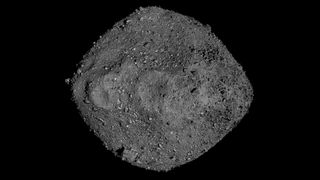It was a close call, but OSIRIS-REx's unexpected adventure might help improve planetary defense techniques.
By Elizabeth Howell published 1 day ago

A mosaic image of the asteroid Bennu created using data from NASA's OSIRIS-REx mission.
(Image credit: NASA/Goddard/University of Arizona)
NASA's asteroid-sampling spacecraft had a near-death experience at Bennu, according to the mission team.
In October 2020, the agency's OSIRIS-REx spacecraft nearly sank into the surface of the rubbly asteroid while picking up rocks for shipment to Earth in 2023, team members revealed Thursday (July 7). The spacecraft only escaped getting stuck or sinking into oblivion within Bennu by firing its thrusters at the right moment.
"We expected the surface to be pretty rigid," principal investigator Dante Lauretta, a planetary scientist at the University of Arizona, told Space.com. "We saw a giant wall of debris flying away from the sample site. For spacecraft operators, it was really frightening."
NASA's asteroid-sampling spacecraft had a near-death experience at Bennu, according to the mission team.
In October 2020, the agency's OSIRIS-REx spacecraft nearly sank into the surface of the rubbly asteroid while picking up rocks for shipment to Earth in 2023, team members revealed Thursday (July 7). The spacecraft only escaped getting stuck or sinking into oblivion within Bennu by firing its thrusters at the right moment.
"We expected the surface to be pretty rigid," principal investigator Dante Lauretta, a planetary scientist at the University of Arizona, told Space.com. "We saw a giant wall of debris flying away from the sample site. For spacecraft operators, it was really frightening."
Now that the spacecraft (more formally known as Origins, Spectral Interpretation, Resource Identification, Security-Regolith Explorer) is safely on its way back to our planet to deliver its precious cargo, scientists are digging into the science implications of the dramatic moment.
"It turns out that the particles making up Bennu's exterior are so loosely packed and lightly bound to each other that they act more like a fluid than a solid," Lauretta said in a University of Arizona statement
That structure is why the OSIRIS-REx sampling probe had such a close call, he and his colleagues determined. The loose surface, made up of particles jostling against each other like plastic balls in a children's play area, has implications for how asteroids were formed and also for planetary defense techniques to protect against potential rogue space rocks coming near our planet, NASA added in a second statement
Photographs from the mission showed a giraffe-scale crater left behind from the brief touchdown, scarring the surface as far as 26 feet (8-meters) wide. That was nothing like the small divot investigators predicted from simulations.
The encounter was a very close call for the spacecraft, mission personnel now say. Where scientists had expected to find a firm surface, the spacecraft experienced resistance comparable to that needed to filter a French press coffee maker, they said.
"By the time we fired our thrusters to leave the surface, we were still plunging into the asteroid," Ron Ballouz, an OSIRIS-REx scientist based at the Johns Hopkins Applied Physics Laboratory in Maryland, said in the University of Arizona statement.
"I think we're still at the beginning of understanding what these bodies are, because they behave in very counterintuitive ways," Patrick Michel, an OSIRIS-REx team member and asteroid scientist at Côte d'Azur Observatory in France, said in the NASA statement.
"I think we're still at the beginning of understanding what these bodies are, because they behave in very counterintuitive ways," Patrick Michel, an OSIRIS-REx team member and asteroid scientist at Côte d'Azur Observatory in France, said in the NASA statement.
No comments:
Post a Comment